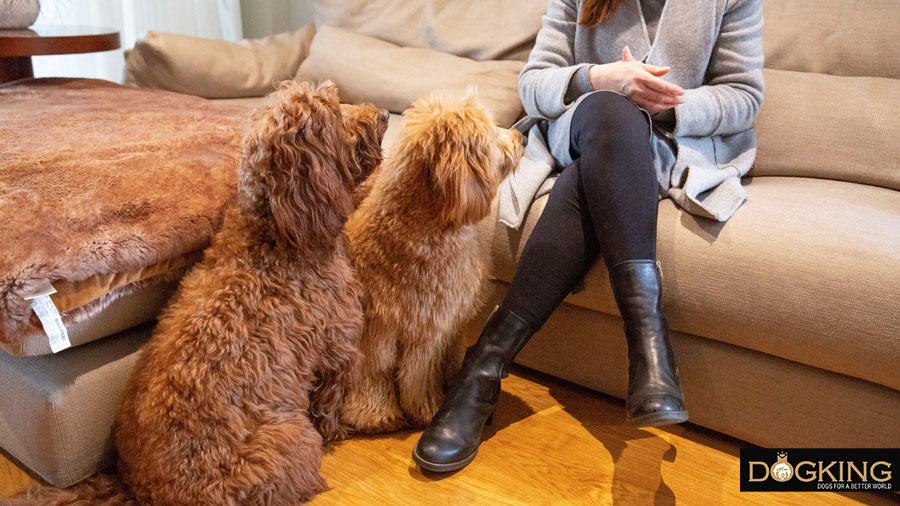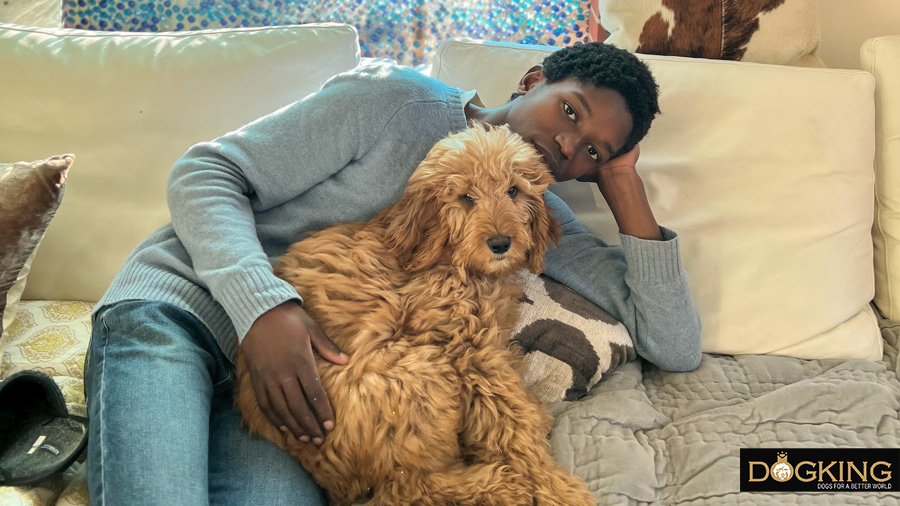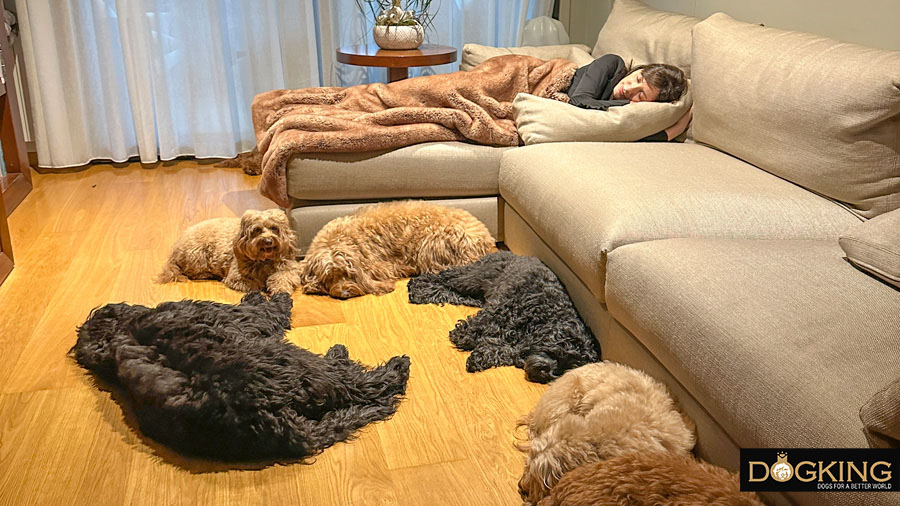Devez-vous laisser votre chien monter sur le canapé ?
Savoir quand et comment fixer des limites

LA BONNE CONDUITE À LA MAISON
Temps de lecture approximatif : 7 minuti
Profiter d'un moment de repos avec votre chien est l'un des plus grands plaisirs qui existent. Mais le canapé est-il un bon endroit pour cela ? Étant donné que nous devons éviter d'humaniser notre chien et que toutes les races n'ont pas exactement les mêmes instincts ou tempéraments, la réponse à cette question dépendra des comportements qui peuvent être déclenchés ou qui se sont déjà manifestés chez votre chien.
Dans cet article, nous vous expliquons quand il n'est pas recommandé de laisser votre chien monter sur le canapé, ce que vous devez prendre en compte si vous le laissez, et comment vous pouvez éviter qu'il le fasse davantage.

Table de matières
1- Est-il bon que votre chien monte sur le canapé ?
2- Comment empêcher votre chien de monter sur le canapé ?
3- Ce qu'il faut savoir si vous partagez le canapé avec votre chien
Est-il bon que votre chien monte sur le canapé ?

Le problème de la dominanceCertains propriétaires, influencés par la pensée classique, craignent souvent que leur chien devienne dominant ou adopte un caractère possessif s'il monte sur le canapé ou le lit. En effet, la dominance est la capacité d'un individu à contrôler une ou plusieurs ressources. Cela fait que le chien se sente libre de faire ce qui lui est le plus gratifiant en croyant avoir une possession totale de la ressource. Bien que cela ne soit pas motivé par le désir d'assumer le rôle de leader au sein de son groupe, se sentir dominant par rapport à certains éléments, comme le canapé, peut entraîner de mauvaises réactions lorsque l'on refuse de reconnaître qu'ils sont de leur propriété.
Comment empêcher votre chien de monter sur le canapé ?
Si nous n'avons pas empêché le chien de monter, nous devrons nous abstenir de donner un renforcement pour que ce comportement cesse par extinction. Il est important de se rappeler que ne pas récompenser des comportements est aussi un renforcement, mais dans ce cas, il s'agit d'un renforcement négatif concernant ce qu'il ne faut pas faire.
Et s'il est déjà sur le canapé, comment le faire descendre ?
- Si nous voulons que notre chien descende du canapé, nous devons l'accompagner et le guider doucement en essayant de le manipuler physiquement le moins possible, car c'est quelque chose qu'il doit apprendre à faire de sa propre volonté. Les punitions et les corrections ne sont pas les plus favorables pour éduquer un chien, elles ne feront que renforcer une hiérarchie qui permettra à notre compagnon à quatre pattes d'obéir aux signaux.
- De plus, les corrections ne doivent jamais être agressives ou impliquer l'utilisation de la force, mais plutôt être exprimées par un ton ferme et des gestes que le chien va associer à des comportements à éviter. Le simple fait de le retirer de l'endroit où il veut être, comme le canapé par exemple, constitue déjà une forme de punition.
- Une fois en bas, nous devrons le récompenser avec un renforcement positif (caresses, nourriture ou mots agréables) afin qu'il comprenne que le fait de descendre peut lui apporter une récompense. Si notre chien n'aime pas être au sol ou n'y est pas habitué, nous lui fournirons un nouvel endroit de repos, que ce soit un lit ou un coussin, mais qui puisse remplacer le canapé. Nous l'exposerons à l'objet, et une fois qu'il sera dessus, qu'il le touche ou le renifle, nous ferons tomber des récompenses jusqu'à ce que notre chien reste dessus et ne descende pas.
- Une fois qu'il a été renforcé pour se coucher sur son nouvel endroit de repos, nous lui apprendrons le signal de « à ta place ». Nous le ferons uniquement lorsque toutes ses besoins auront été satisfaits (sortir pour une promenade, manger, etc.), car nous ne pouvons pas attendre que notre chien veuille se reposer s'il a passé toute la journée à la maison, par exemple. Nous devons être cohérents, faciliter notre travail en équilibrant ses niveaux d'énergie, et faire de cela une expérience amusante et motivante pour nous deux.
Ce qu'il faut savoir si vous partagez le canapé avec votre chien
Limites au comportement des chiens
¿P------------------------------falta?
La meilleure façon de montrer notre amour à notre chien est de garantir sa sécurité, tant mentale que physique, et cela nécessite d'établir certaines limites. Les limites, si elles sont intégrées dès leur jeune âge, peuvent l'accompagner tout au long de sa vie et favoriser une coexistence harmonieuse avec le reste de la société, tout comme cela se ferait avec sa meute. En fin de compte, permettre des comportements inappropriés ne fera que nuire à sa compréhension pour se sentir accepté par d'autres humains et chiens. En outre, au-delà d'entraver son apprentissage, le fait de monter sur le canapé peut également poser un problème d'hygiène selon la race en raison de la quantité de poils que votre chien perd, surtout s'il y a des personnes allergiques à la maison.
Quand devons-nous poser des limites ?
Tout dépendra en grande partie du type de race. Certaines races auront dans leur ADN une plus grande prédisposition à provoquer des allergies, ou des instincts plus dominants ou possessifs qui les amèneront à résister davantage à descendre du canapé contre leur gré. Ainsi, si le tempérament de votre chien a du mal à apprendre des limites en raison de son caractère, montrant éventuellement de l'agressivité pour protéger une ressource, ou s'il appartient à une race qui perd beaucoup de poils, il sera préférable de lui attribuer un nouvel endroit où se reposer, en alternative au canapé.

Dans le cas des Australian Cobberdogs, dotés d'un caractère facile à éduquer grâce à leur intelligence remarquable et à un pelage hypoallergénique, ils sont les chiens par excellence pour la cohabitation. Leur apprendre à monter ou descendre du canapé ne posera aucune difficulté, bien au contraire, étant donné leur volonté d'apprendre. Ce qui est important pour eux, c'est de pouvoir être avec vous, peu importe l'endroit, ce qui fait de l'éducation une activité que vous apprécierez tous les deux, et le canapé ne sera qu'un élément secondaire.